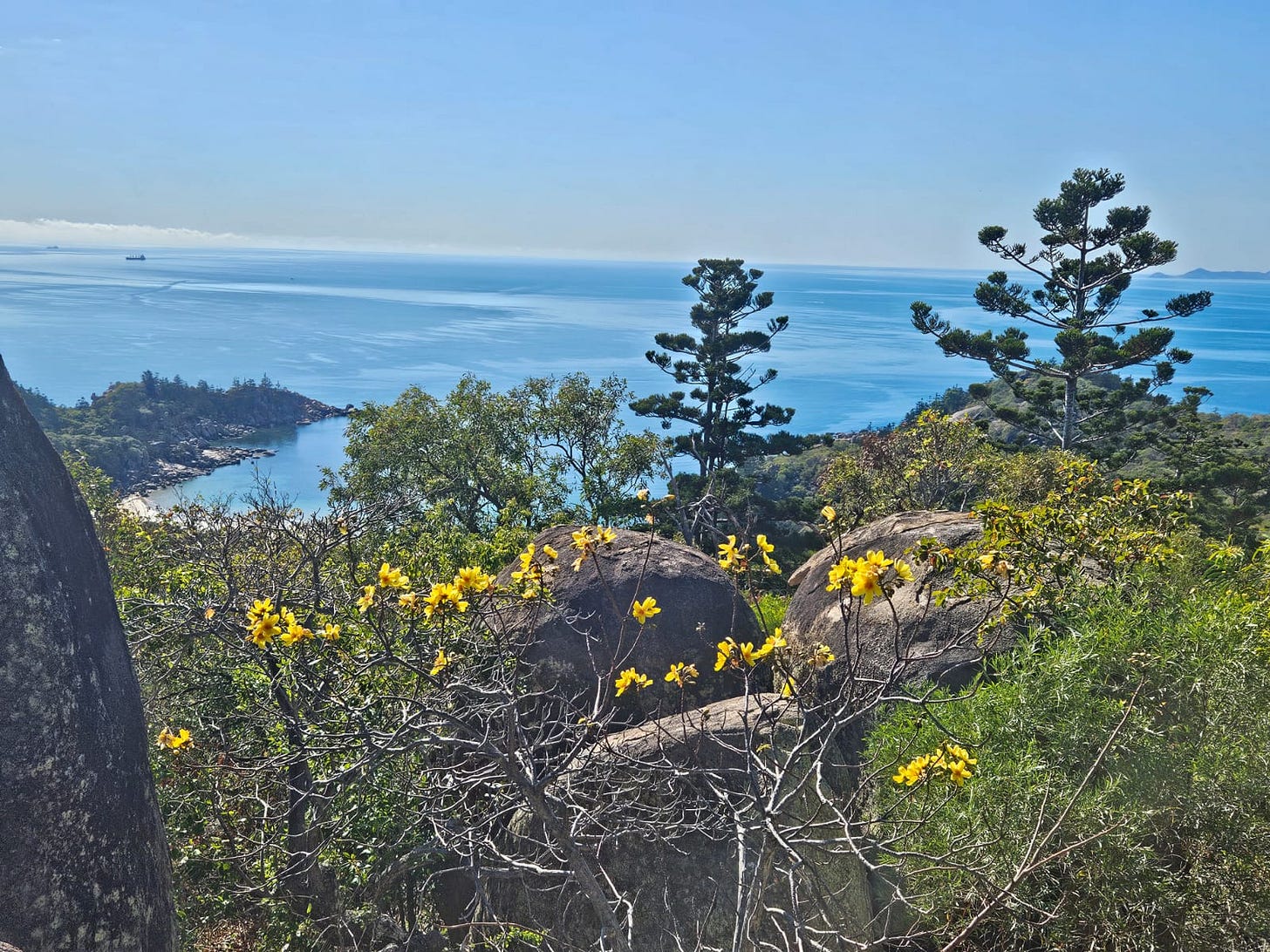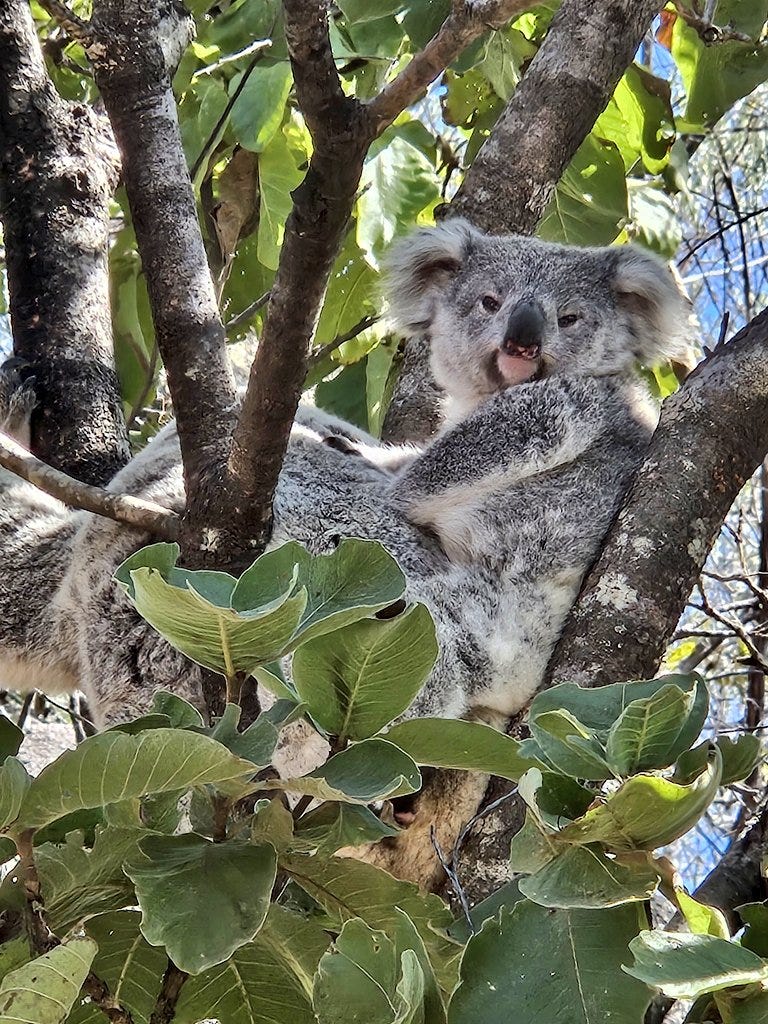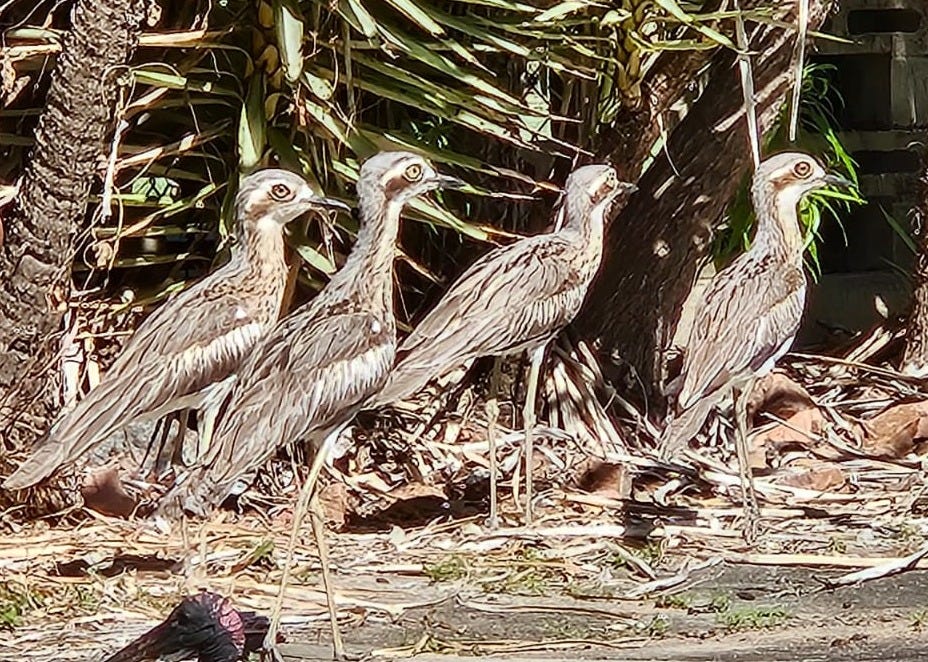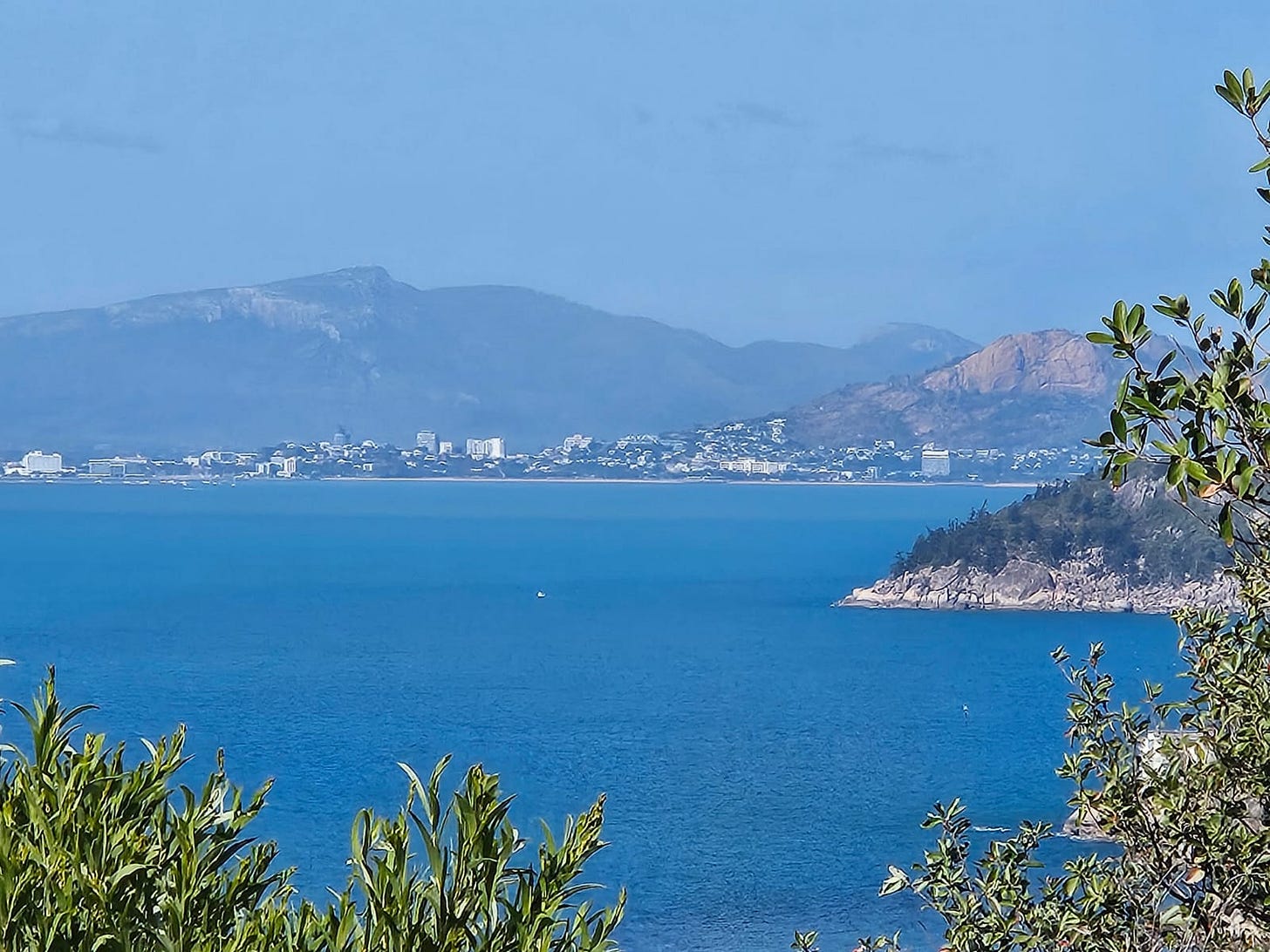Townsville, Queen of the Sea
An underrated piece of paradise
The beginning of the journey is deceptively mundane. I hand the bus driver my 50 cent coin, which makes an old-fashioned clink as he funnels it into a slot in a metal change machine—it’s the first time in years that I’ve paid for anything without my mobile phone and the first in perhaps a decade I’ve had to fish out a physical coin. The twenty-minute drive takes us along an endless straight road, lined with box stores and strip malls. Only the ambient temperature hints at exoticism: half an hour after dawn on a late winter morning, I am bare-armed and already regret having slipped a superfluous cardigan into my bag. The ferry terminal is a featureless grey box and a queue of people sporting their unsmiling, vaguely jaded Monday morning expressions are waiting at a concession stand for their flat whites to be frothed.
But almost as soon as the ferry begins to nose its way out of the long channel of water, I feel the exhilaration building. We slip past cranes and containers—all the lovely accoutrements of a working port—and then out onto an expanse of electric blue, smooth as freshly ironed silk, except where our wake leaves the broad V of its furrow. As we glide out to sea, the view of the town emerges: the front of the hump of Castle Rock, the cafés and bars of the Townsville’s strand, which are laid out along a huge scoop of bay and peter out quickly into low-slung houses along an endless curve of sand. To both port and starboard, both ahead and behind, there are jagged ridges of smoke-blue hills; ahead, more lovely hills, this time forested, as our destination island approaches.
I normally pop my earbuds in as soon as I embark on any mode of transport. But although I’m halfway through an engrossing account of Mary Queen of Scots on The Rest is History, I spend the whole journey just gazing at the quiet blue. It’s remarkable: there is so little to see and yet my eye doesn’t tire of the loveliness of that colour. The journey is over in less than half an hour—it’s a shorter trip than my habitual ferry journey down the wide Parramatta River and into Sydney harbour. Yet it’s just enough time to stir those ancestral memories—fainter now in a world of commercial flights and yet even on a brief ferry that crosses this stretch of sea ten times a day, palpable. I feel it: that heady sensation of leaving the familiarity of land and setting sail on an adventure.
Magnetic Island is a place of wonders. Despite the tropical promise of a 33 Celsius winter day, the hills have an Italian feel to me: dry pale ground and discarded twigs underfoot and tall bare tree trunk ending in greyish green leaves—although of course this is the grey of eucalptys not that of olives and the conifers interspersed between them are hoop pines, not cypresses. Amid the muted grey-greens and grey-browns, the Kapok trees hoist their buttercup-yellow, open-petalled flowers towards the sky. In a fork among the branches of a tree adjoining the road, there is a mottled grey-and-white bundle of fur: koalas. The mother’s soft bottom is squashed flat against one branch while her forehead is resting against another, bowed, eyes shut. Her joey peeks out at us and then half-stands, staring half-quizzically, half-defiantly, like any human toddler. His ears are furry muffs.
There are birds too: raucous parrots many and various, the lovely rainbow lorikeets that can be found everywhere in Australia, of course, but also kingfishers, perched in pairs on high branches, gleaming spearmint and turquoise. Hawks ride the thermals far above. And, as I round a corner, a wallaby with its round ears like a cartoon mouse, looks at me for an instance from its perch on a rock and then bounds away. From the summit of every hill I climb, there is a long sweeping vista around the island, overlooking beach after scalloped beach. In the distance, I can see twin ferries crossing the smooth water, one in each direction, and on the far horizon, those fairytale blue mountain ridges.
The road from the walking track to the bay meanders down into a picturesque suburbia of broad empty roads and thick springy grass verges. Backpackers in crop shorts and singlets are drinking iced lattes at a small cafe across the road from the beach. A line of banyan trees fringes the sand, which is empty except for a single family, some way off. I scramble into my bikini from inside my tent-like kaftan (this is Australia, country of prudes) and walk into a sea barely cool. There’s no shock of cold as the water laps at my thighs and belly. I swim a few dozen strokes back and forth before just lazily treading water, with my goggles pushed up to my forehead, so I can view the world from literal sea level. From here, it looks like a present, wrapped in a crinkly azure foil, carefully smoothed out by meticulous fingers.
The first glimpses of Townsville from the airport make it look genteel but unremarkable: an expanse of sprawling car-centric suburbia that could be anywhere in Middle America. But the Australians are a centripetal people and here, as elsewhere, everything is centred on the coastline. This is clearly the best time of year to be here, while the sun is warming but not yet ferocious (and it’s still chilly and grey in much of the rest of the country) and the sea is free from jellyfish (“marine stingers” is the official designation—a characteristically casual Aussie turn of phrase) so you can swim anywhere along the enormous crescent of coastline, rather than only within nets. Yet Townsville has the feel of an off-season beach town, a charming, sleepy, unspoiled vibe. There is a huge “rock pool”—a misnomer for what in Sydney would be an ocean pool, a man-made structure, walled off from the open sea beyond, but with expansive views out across the cobalt blue to the wooded hills of Magnetic Island. A freestanding building that looks like a swimming pavilion houses Juliette’s Gelateria. At night, its cherry red logo glows invitingly and it’s equipped with deckchairs looking out at the endlessly beautiful sea vista.
At the weekend, there’s a little more bustle: a few people are drinking beers on the covered deck of a beachside bar; the main drag of the esplanade is busy with electric scooters. But even on a Saturday, after walking just a little further around and out towards the tip of the nearest cape, up the gravel paths of a small promontory and over a raised wooden walkway, I am alone. And from that vantage point, I see just a single line of houses along the coastal walkway, looking as if they could be swept up and cleared away as easily as a child's lego blocks. As so often in Australia, I have a sense that the modern constructions are perched lightly on the landscape: fragile, recent. It’s easy to imagine what Captain Cook must have seen as he sailed along past this place in 1770—he would surely not be too astonished if he were to gaze out at Townsville today from the 9.30am ferry from Nelly Bay.
Townsville is a place of expansive views. From the first floor of the café above the Rock Pool, from the modest hill at Jezzine Barracks, even from the two-metre elevation of the wooden walkway that leads out of town and begins the long, inviting path to Cape Pallerenda, you have a panorama: the big C curve of the coastline, fringed with yellow sand, the turquoise water and the hills in front, behind and to either side. You never lose the sensation of being poised on Australia’s salty, scalloped edge. The views are best, though, from the top of Castle Rock—a kind of miniature wooded Uluru that dominates the city skyline, its lopsided hump reminding me of the boa who swallowed the elephant in The Little Prince. On the drive up the slopes leading to the beginning of the walking path, we pass through a genteel suburb of decorous white slatted-wood Queenslander houses that front the ocean, enjoying views that have made them the most expensive real estate in the country outside Sydney. Then the climb upwards through the wooded slopes to the summit is steep but brief. I’m looking down to find my footing when a loud rustle of foliage and a familiar thumping cause me to look up to see that I’ve startled a mob of kangaroos who are bouncing off into the thicket.
The wildlife is all around. Wallabies are everywhere: in the park opposite my hosts’ house, on the university campus—everywhere there is a grassy patch larger than a front lawn. I watch one stand nonchalantly in a tangled patch of long grass as a Pomeranian yaps at it from a fenced-in backyard. I spot the doll-like face of a joey gazing wide-eyed at me from one wallaby pouch; from another pouch protrude two spindly legs, like the poles of a tent hastily stuffed into a canvas bag. Elegant stone curlews in their restrained brown-and-grey plumage strut around everywhere from parks to car parks, in pairs, trios and quartets. There are streams full of turtles who are clearly regularly fed as they swim up to the bank to greet me hopefully, their little bug-eyed domed heads poking up above the water. And in the warm air, there are more flashes of electric blue that echoes the colour of the ocean but this time dauntily trimmed with black: Ulysses butterflies. Slung into the V of the branches of a tree, we spot a dozing carpet python.
Townsville has a down-to-earth charm and a kind of frontier town vibe, with abundant utes, leathery-skinned men in cowboy hats and more members of the male sex sporting moustache-and-sideburns facial hairstyles and old-fashioned sleeve tattoos than I’d seen in a while, down here in prissier, more pretentious Sydney. And while the avocado toasts were ubiquitous—as throughout Australia—there were a lot of people eating mince and hot pies and display cases at cafes were more likely to be stuffed with sausage rolls than with Dubai-chocolate-filled mochi cronuts. I met a Bob Katter look-and-soundalike at every turn—and even went on a date with one, though that did not work out well, sadly, as I was already planning my new life in a tropical paradise with my Queensland man.
There were also many Aboriginal people around town—looking like normal, gainfully employed and upstanding citizens. One such lady operates the ticket booth at the ferry; I encountered another drinking a long black at a local café; a cheery guy at the Sunday market sported his own colourful sweatshirt and cap, adorned with indigenous designs, and chatted happily to us about his business. The few Aboriginals I had previously seen in Australia (most of them in Adelaide) had been lolling on the street dead drunk and looking homeless and destitute. I add this not as a political statement or judgement of any kind—I can’t begin to even get a grasp on the complex causes of the problems facing that community let alone suggest any possible solutions. I just want to note that I really liked encountering some who seemed to be flourishing and it was the first time I had had that good experience.
What most struck me in Townsville, though, was the casual abundance of Australia: it was a drier, less lush and sodden part of the tropics than I was expecting, but it was still unmistakably opulent. Before my visit, no one told me what a breathtakingly beautiful place it is. People even shrugged at the idea when I told them I would be visiting, as if to say Meh, it’s nothing special. Just your basic paradise. Australians have grown blasé about the idylls on their doorstep. If there’s one thing I hope I can do it’s to tell them in words, to show them in my wide-eyed gaze, just what a gorgeous, enchanted land we live in here.





